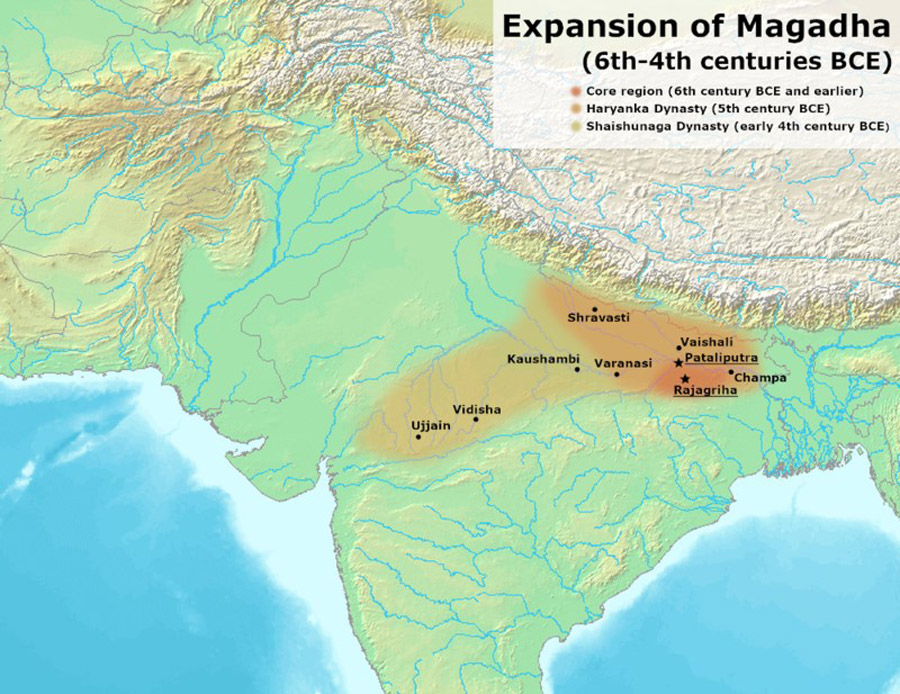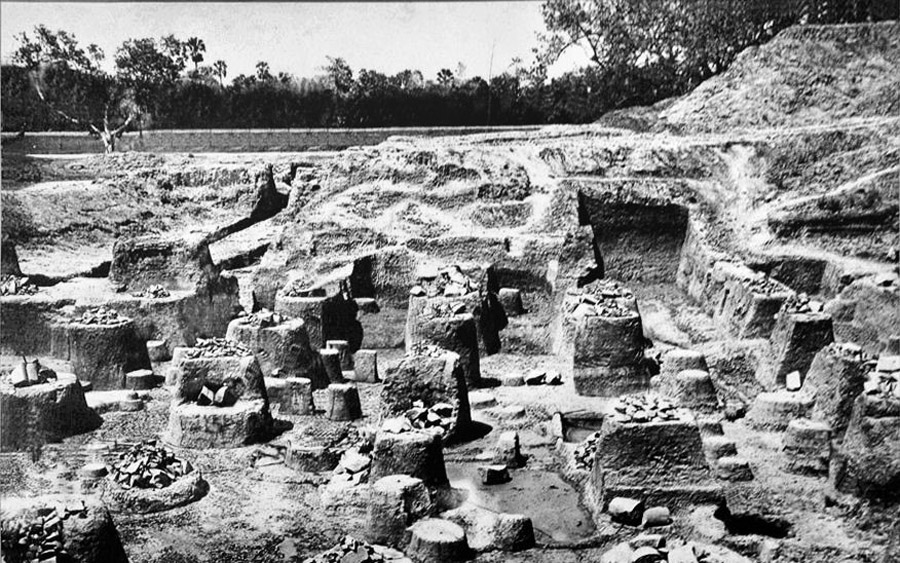In the far northeast of India, on the great plains south of the foothills of the Himalayas, lies the ruins of a vast and ancient city. Pataliputra was founded during the life of the Buddha, and bore witness to the next 1,500 years of Indian history.
No fewer than five Indian empires chose Pataliputra as their capital, and the city grew to be the center of Indian culture in the region for centuries. During the Maurya empire in the 3rd century BC, it was the largest city in the world.
Although not the oldest such city in India – the ancient cities of Pushkalavati, Takshasila, Hastinapura, Mathura, Ayodhya for example are older – Pataliputra rose to pre-eminence as the center of the northern Indian world for generation after generation. Today the remains of this huge, fortified city lie largely hidden beneath its modern successor, Patna.
Founding of Pataliputra
Pataliputra lies at a natural meeting point, the junction of the mighty Son and sacred Ganges rivers. It is the city of North-eastern India. Centrally located in the region and easily accessible because of these navigable rivers, it was a natural site for an administrative center for the surrounding area.
Ajatashatru, a king of the Haryanka dynasty and ruler of the great kingdom of Magadha in east India certainly thought so. The king built an initial fort at this strategic point to control the surrounding lands.
Buddhist sources confirm the founding of a city on this location at this point, towards the end of the Buddha’s life. According to Buddhist tradition, Ajatasharu was succeeded (and possibly murdered) by his son and successor Udayin, who built the first city of Pataliputra during his rule around 460 BC.
Udayin moved his capital to Pataliputra during his reign, attracted by the central location and wishing to place himself at a strong defensible point to counter the aggression of his neighbors, the Pradyota. From this stronghold, he was able to resist these attacks, winning several victories against Pradyota attacks from Avanti to the west.

Udayin however was ultimately defeated by Palaka of Aventi, being assassinated by the rival kingdom in 444 BC. His line of succession is unclear, but it appears that by 421 BC a subsequent dynasty of the Magadha, the Shisunaga Empire, had arisen to replace the Haryanka.
- Hattusa: The Great Hittite City At The Edge Of The World
- Vimanas, The Hindu Machines: Did Ancient India Have Flying Saucers?
Some sources state that it was a king of this dynasty who chose Pataliputra as their capital. Nevertheless, by the 3rd century BC Pataliputra was established as the capital of an empire.
Capital of Five Empires
India during this period was war-torn and territories were won and lost frequently by successive empires. Through all this Pataliputra endured, and was chosen again and again as the capital city of the successive empires in the region.
Dates are unclear as to the order of succession at this time, but it seems the Nanda Empire overthrew the Shisunaga, coming to rule the region from Pataliputra around 345 BC. The city grew wealthy under the Nanda kings.
The last Nanda king was overthrown by Chandragupta Maurya around 322BC. This famous figure in Indian history carved out one of the largest empires ever seen on the Indian subcontinent. Under the Mauryas the population of the city would be larger than at any other time until the 1960s.
Taking advantage of the chaos left from the invasion of Alexander the Great, Chandragupta Maurya rapidly expanded westwards, conquering the regional rulers until his empire covered more than half of modern India. With Pataliputra as his capital, the city grew to vast proportions.
Covering an area of more than 25 square kilometers (9.6 square miles) and with a population of up to 400,000 people, Pataliputra was now the largest city in the world. Surrounded by defensive walls running 33.8 km (21 miles) and with 64 gates, one every 500 m (1640 feet), the city would have been impressive indeed.
Megasthenes and the Seleucids
From his great capital, Chandragupta fought for territory against Seleucus Nicator, who was Alexander’s successor and also the founder of the Seleucid Empire. Seleucus sent an ambassador named Megasthenes to Pataliputra after making peace with Chandragupta.

Megasthenes maintained a diary of his own stay in India, which offers a unique perspective on the great city. Today, segments of this diary survive as quotations including a description of Pataliputra.
From what survives, Megasthenes was clearly impressed by the great Maurya city, with its great walls and fortifications. He also that Pataliputra was amongst the first cities across the globe to have a sustainable local self-government.
Capital of Later Empires
After the collapse of the Maurya Empire and the assassination of its last king in 180 BC, Pataliputra entered something of a dark age. Although still a huge city and an important regional center, it would not again become the capital of an empire until the rise of the Guptas 500 years later.
- Derinkuyu: History of Turkey’s Underground City
- Pushyabhuti: What Became of the Forgotten Indian Dynasty?
The Guptas ruled from 320 to 467 AD, over what is described as the Golden Age of India. As capital of the Gupta and later Pala empires, Pataliputra remained at the heart of Indian empires until the twelfth century.
Records from this time are sometimes fragmentary and it is not entirely clear what importance Pataliputra held after this time. However, the strategic location was still important to Indian kings and in 1537 Sher Shah Suri, founder of the Suri empire, established a new city at the site over the remains: the city of Patna.
A Preferred Capital for 1,500 Years
As stated above, there were many empires that counted on Pataliputra as their imperial capital. The principal reason for this popularity was the location of this city. The location was quite strategic, as it is in the exact central site of north-eastern India.
As Pataliputra was the most important and largest city of India for many centuries, it was natural that successive dynasties would choose it as their capital. And this recognition for this city is engraved forever in Indian antiquity.
The city had protection with massive timber palisades split by 64 gates, making the city almost impregnable. It was also surrounded by 570 towers and a deep and broad moat, which was also used as an outlet for the city sewers. It was said that the Royal Palace of Chandragupta Maurya in the city, although completely built of Timber, had pillars of gold and silver.
Such a clear statement of power for its rulers led to legendary associations. Megasthenes stated that he was told the divine founder of this city was Balarama, Krishna’s brother, known to the Greeks as Heracles.

Rediscovered by archaeologists in 1892, much of the city remains beyond the reach of modern day archaeology. Much of the wooden city will not have survived, leaving only ghostly shadows in the ground to mark its existence.
Like Herculaneum in Italy, the modern city which sits atop Pataliputra prevents excavation. Who knows what treasures, and secrets, the great city is hiding, deep underground.
Top Image: Artist impression of Ashoka Mauyra’s palace at Pataliputra, and a griffin excavated from the site. Source: Unknown Author / Public Domain; Ramaprasad Chandra / Public Domain.
By Bipim Dimri